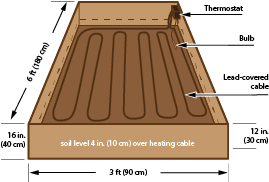Early start on growing vegetables
Starting Plants Indoors
Growing your own transplants indoors can extend your gardening season by several weeks, reduce your gardening costs, and allow you to grow transplants of some of the hard-to-find varieties of crops. In general, seed should be sown from 6 to 8 weeks before the date that you wish to set the plants in the garden.
Successful plant starting requires:
- suitable soil mix
- suitable containers
- proper moisture
- temperature and aeration
- adequate light
- conditioning plants to the outdoors
To get a head start on a vegetable garden, you can also start seed in a hotbed or cold frame in order to transplant young plants early in the season. Use any extra space to produce early crops of small vegetables, such as radishes, spinach, and lettuce.

Making a hotbed or cold frame
One 3-by-6-foot hotbed or cold frame sash is enough for the average home garden. Place the sash where there is:
- protection from strong, prevailing winds
- good natural drainage
- abundant sunlight
- available water supply
Make the sash frame out of wood, preferably redwood because it withstands weather well. The north end of the frame should be 16 inches deep and the south end 12 inches deep. This design allows water to drain off easily and the sun to heat the soil effectively. Place 4 to 6 inches of good soil in a pit the size of the sash. Add enough good soil so the surface is even with the soil surface at the bottom of the boards.
There are several methods of furnishing supplementary heat to a hotbed:
- manure
- hot air
- hot water
- steam
- electric heating cable or special heating mats
The above have been used and all can work well. Sometimes light bulbs are used as a source of heat in a small hotbed; they are not effective in heating the soil.
Heating mats or weatherproof electric heating cables are inexpensive means for heating soil and plants in a garden hotbed. A 3-by-6-foot hotbed heated by electric cable commonly uses 1 kilowatt-hour of electricity per day. Use a cable of the right length and correct type to deliver 150 to 200 watts to the hotbed. To provide this amount of heat to a 3-by-6-foot hotbed, use 60 feet of number 19, lead-sheathed or similar weatherproof, cut-resistant heating cable. Use a thermostat to control the temperature, because this type of cable can supply about 400 watts at 110 volts of AC current. Lay the cable about 3 to 4 inches below the soil surface. Accurately follow the manufacturer’s recommendations for installing the cable. Be careful not to damage the cable when spading the soil in the hotbed.
Heating mats placed under trays of plants or plants in individual containers can provide similar benefits. Of the several materials that can be used to cover a hotbed or cold frame, window glass is the best and the most expensive. More light passes through glass, which keeps the bed warmer than do other materials. Polyethylene plastic also serves as a good sash cover. It is cheaper than glass but must be replaced every year. On cold nights, however, place an additional cover, such as a blanket, canvas, or mats, over the glass or plastic to retain more heat in the bed. Be sure to remove the extra cover during the day.
Plant seeds in the hotbed in rows about 4 inches apart. Cover seeds with about 1⁄2 inch of soil. Seeds germinate best at temperatures of 65° to 75°F. You can lower the temperature through ventilation or raise it by using a transparent cover (plastic or glass). Seeds may also be planted in containers filled with soil mix that is placed in the hotbed. When the seedlings emerge, thin them so they are 2 inches apart in the row. Use a pencil or small dibble to thin and make planting holes. Make sure the seedlings receive plenty of sun and good ventilation. Do not allow the temperature in the hotbed to become too warm; high temperatures cause plants to become weak, leggy, and subject to disease. On warm, sunny days, provide ventilation by propping up the cover at one end of the bed or on the side away from the wind. When transplanting young plants to the garden, take up some soil with each plant as you remove it from the flat. Use a trowel for making planting holes. Lightly firm the soil around each plant, then water gently.
Row covers, hot caps, and similar devices
Another method of promoting early plant growth and production is to cover seeds or young plants in the field with polyethylene row covers, paper hot caps, discarded plastic gallon water or milk containers with bottoms removed, or similar heat-trapping devices. These coverings keep daytime air temperature higher but have a limited effect on soil or night temperatures. If you use them, you must harden the plants before completely removing the covering.
When the plants start to fill the air space inside the covering, gradually harden the plants by opening the device slightly on the north side. Gradually increase the amount of plant exposure over a week or two. You may take off the covering temporarily for thinning and weeding the seedlings. The covers may be removed on sunny warm days to prevent them from overheating the plants inside.
